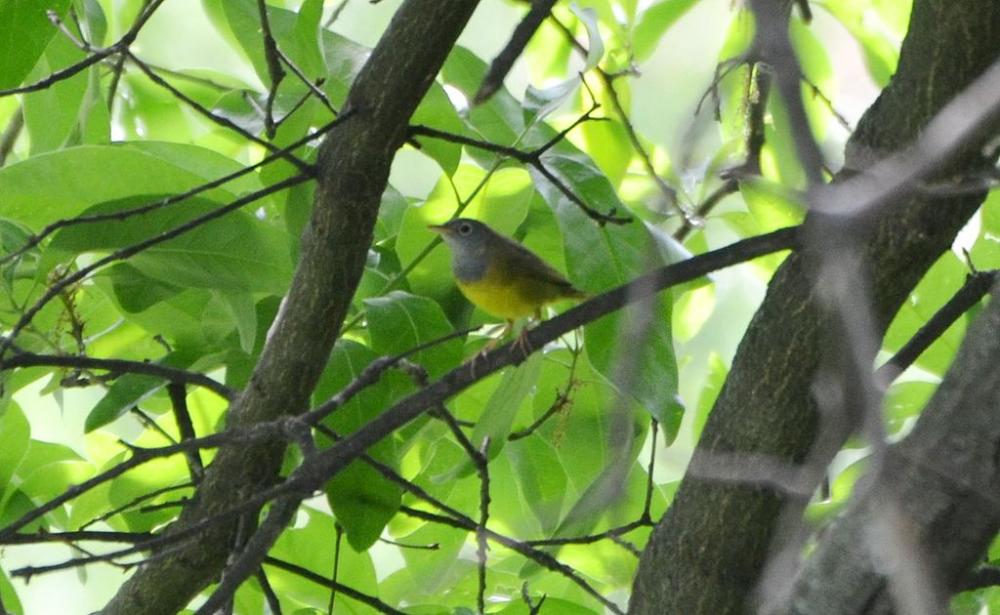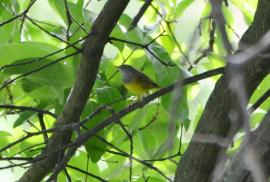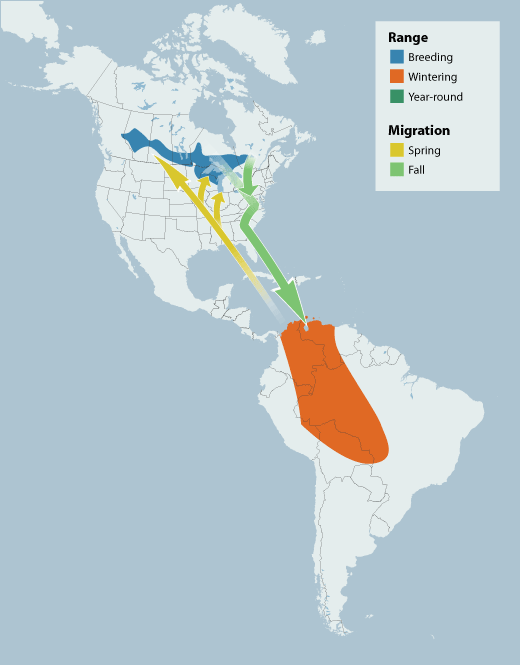Guide to Boreal Birds
This is an in-depth boreal species profile.
What is this?
This species is one of more than 30 birds selected for in-depth profiles. Find out why and see all selected boreal birds »
Overview
Due to its restricted range, inaccessible and insect-rich breeding habitat, and secretive nature, the poorly named Connecticut Warbler is one of the least known birds in North America and remains on many birders' wish lists. Named for its place of discovery, this species is only an uncommon migrant in Connecticut. The bird is seldom seen except by observers who know where to look. During spring migration, it feeds close to the ground in dense swampy woods; in the fall, it occurs most often in woodland edges where the growth is rank. Almost nothing was known about it until fairly recently – it was nearly 70 years between the time of its discovery and the first description of its nest, in 1883 – and the situation is little improved today. To date, no rigorous field studies have been conducted on this species, and much of its life history remains a mystery.
Description
5 1/2" (14 cm). Olive green above, dull yellow below; head, throat, and upper breast gray in males and dull brownish in females. Has conspicuous, unbroken white eye ring. No wing bars. Mourning Warbler similar but has faint, broken eye ring.
Voice
A loud, ringing beecher-beecher-beecher-beecher or chippy-chipper-chippy-chipper.
Nesting
4 or 5 whitish eggs, blotched with brown, in a nest of grass concealed in a clump of moss.
Habitat
On the breeding grounds, the Connecticut Warbler is partial to brushy margins of open woods, especially wet areas such as the edges of spruce bogs and meadows. It seeks out similar habitat during migration, when it is found in wet thickets, overgrown ditches, swamps, cloud forest, alpine grassland, and brushy pastures. Its habitat preference on the winter grounds is poorly known but appears to be similar in terms of cover, though perhaps less water-associated; it has been found in woodlands, forest edge, shrubby second growth, and tropical rain forest, up to 4,200 meters (13,800 ft) elevation.
Range/Migration
The Connecticut Warbler, like the Blackpoll Warbler (Dendroica striata), is unusual among passerines in that it has an elliptical migration route spanning largely distinct areas in spring and fall. It departs the breeding grounds beginning in mid-August, with the last individuals leaving by late September in the West to early October in the South. Most of the population heads east to southeastern New England and then heads south to South America. How it got there was long a mystery until a Manitoba-based research team tracked individuals making an over-ocean flight from the U.S. Atlantic coast down to the Greater Antilles and beyond. The winter range, though poorly known, appears to lie entirely within the western Amazon Basin. Northward migration is relatively late, most individuals traversing the West Indies back to Florida; they then head northwest and up the Mississippi Valley, arriving on the breeding grounds in mid-to late May.
Breeding
Ninety-two percent of the global population of Connecticut Warblers breeds in low-elevation boreal forests of North America. The breeding range extends from eastern British Columbia to western Quebec and south to northern Wisconsin. What little information is available on the species' breeding ecology suggests that it is similar in most regards to that of its closest relatives, the MacGillivray's (O. tolmiei) and Mourning (O. philadelphia) Warblers. The Connecticut Warbler is seasonally monogamous and territorial, the males establishing and defending territories ranging in size from about 1/4 hectare (0.6 acres) in open forest to 1/2 hectare (1.25 acres) in closed forest, where terrestrial arthropod densities are lower. Nesting begins in late May in the southern part of its range and extends into August; there is only one brood per year. Nest observations are few because the parents walk through thick cover the last 10 to 15 meters (33-50 ft) to conceal the nest location. The cup nest is hidden on or near the ground and made of grasses, leaves, weed stalks, stems, rootlets, horsehairs, etc. Three to five (usually four) creamy white, speckled eggs are laid and incubated for an unknown length of time by the female alone. The nestling period is unknown; both parents feed the young. Families remain together at least two weeks after fledging, sometimes forming small flocks with other families. Parasitism by the Brown-headed Cowbird (Molothrus ater) has been documented but probably is infrequent.
Diet/Feeding Behavior
The Connecticut Warbler is believed to be primarily insectivorous year-round, though it does eat some seeds and berries, at least seasonally. It forages on the ground and along low branches, occasionally higher in trees. Other aspects of the species' diet and feeding behavior, like much of its ecology, remain unstudied.
References
Harrison, H.H. 1984. Wood warbler's world. Simon and Schuster, New York.
McKinnon, E. A., C. Artuso, and O.P. Love. 2017. The mystery of the missing warbler. Ecology. doi:10.1002/ecy.1844
Pittocchelli, J., J. Bouchie, and D. Jones. 1997. Connecticut Warbler (Oporornis agilis). In The Birds of North America, No. 320 (A. Poole and F. Gill, Eds.). Philadelphia: The Academy of Natural Sciences; Washington, D.C.: The American Ornithologists' Union.
Sauer, J. R., J. E. Hines, and J. Fallon. 2003. The North American Breeding Bird Survey, Results and Analysis 1966-2002, Version 2003.1, USGS Patuxent Wildlife Research Center, Laurel, MD.
Credits
Birding content provided by National Wildlife Federation/eNature, with support from Ducks Unlimited/The Pew Charitable Trusts.





